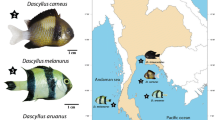Abstract
Three different fluorochrome and specific counterstain combination (DAPI/AMD, DA/DAPI and CMA/DA) treatments were applied to the chromosomes of four Microtidae (Rodentia) species. The results complete the data obtained in our previous paper (Burgos, M., Jiménez, R., & Dìaz de la Guardia, R., Genome 30:540–546, 1988) and prove that the changes in the constitutive heterochromatin in the evolution of the karyotypes of these species are not only due to gain or loss of heterochromatin, but are qualitative with respect to their nucleotide composition, repeated base pair organization or DNA-protein complex modification. These variations lead to the differential response to the fluorescence dye combinations used.
Similar content being viewed by others
References
Bogenberger, J.M., Neitzel, H. & Fitter, F., 1987. A higly repetitive DNA component common to all Cervidae: its organization and chromosomal distribution during evolution. Chromosoma 95: 154–161.
Burgos, M., Jiménez, R. & Díaz de la Guardia, R., 1986. A rapid, simple and reliable combined method for G-banding mammalian and human chromosomes. Stain Technol. 61: 257–250.
Burgos, M., Jiménez, R. & Díaz de la Guardia, R., 1988a. Comparative study of G- and C-banded chromosomes of five species of Microtidae: a chromosomal evolution analysis. Genome 30: 540–546.
Burgos, M., Jiménez, R., Olmos, D. M. & Díaz de la Guardia, R., 1988b. Heterogeneous heterochromatin and size variation in the sex chromosomes of Microtus cabrerae. Cytogenet. Cell Genet. 47: 75–79.
Gadi, I.K. & Ryder, O.A., 1983. Molecular cytogenetics of the Equidae. II. Purification and cytological localization of a (G+C)-rich satellite DNA from Equus hemionus onager and cross-species hybridization to E. asinus chromosomes. Cytogenet. Cell Genet. 35: 124–130.
John, B., King, M., Schweizer, D. & Mendelak, M., 1985. Equilocality of heterochromatin distribution and heterochromatin heterogeneity in acridid grasshoppers. Chromosoma 91: 185–200.
Mayr, B., Krutzler, J., Auer, H., Kalat, M. & Schleger, W., 1987. NORs, heterochromatin, and R-bands in three species of Cervidae. J. Hered. 78 (2): 108–110.
Mayr, B. Schweizer, D., Mendelak, M., Krutzler, J., Schleger, W., Kalat, M. & Auer, H., 1985. Levels of conservation and variation of heterochromatin and nucleolus organizers in the Bovidae. Can. J. Genet. Cytol. 27: 665–682.
Miller, O.J., Schnedl, W., Allen, J. & Erlanger, B.F., 1974. 5-methylcytosine localised mammalian constitutive heterochromatin. Nature 251: 636–637.
Scherthan, H., Arnason, U. & Lima-de-Faria, A., 1987. The chromosome field theory tested in muntjac species by DNA cloning and hybridization. Hereditas 107: 175–184.
Schnedl, W., Abraham, R., Förster, M. & Schweizer, D., 1981. Differential fluorescent staining of porcine heterochromatin by chromomycin A3/distamicin A/DAPI and D 287/170. Cytogenet. Cell Genet. 31: 249–253.
Schnedl, W., Dann, O. & Schweizer, D., 1980. Effects of counterstaining with DNA binding drugs on fluorescent banding pattern of human and mammalian chromosomes. Eur. J. Cell Biol. 20: 290–296.
Schnedl, W., Dev, V. G., Tantravahi, R., Miller, D. A., Erlanger, B. F. & Miller, O. J., 1975. 5-methylcytosine in heterochromatic regions of chromosomes: chimpanzee and gorilla compared to the human. Chromosoma 52: 59–66.
Schweizer, D., 1981. Counterstain enhanced chromosome banding. Hum. Genet. 57: 1–14.
Schweizer, D., Ambros, P. & Andrle, M., 1978. Modification of DAPI banding on human chromosomes by prestaining with DNA binding oligopeptide antibiotic, distamycin A. Expl Cell Res. 111: 327–332.
Schweizer, D., Ambros, P., Andrle, M., Rett, A. & Fiedler, W., 1979. Demonstration of specific heterochromatic segments in the orangutan (Pongo pigmaeus) by a distamycin/DAPI double staining technique. Cytogenet. Cell Genet. 24: 7–14.
Sen, S. & Sharma, T., 1983. Role of constitutive heterochromatin in evolutionary divergence: results of chromosome banding and condensation inhibition studies in Mus musculus, Mus booduga and Mus dunni. Evolution 37: 628–636.
Sumner, A. T., 1972. A simple technique for demonstrating centromeric heterochromatin Expl Cell Res. 75: 304–306.
Author information
Authors and Affiliations
Rights and permissions
About this article
Cite this article
Burgos, M., Olmos, D.M., Jiménez, R. et al. Fluorescence banding in four species of Microtidae: an analysis of the evolutive changes of the constitutive heterochromatin. Genetica 81, 11–16 (1990). https://doi.org/10.1007/BF00055231
Received:
Accepted:
Issue Date:
DOI: https://doi.org/10.1007/BF00055231




